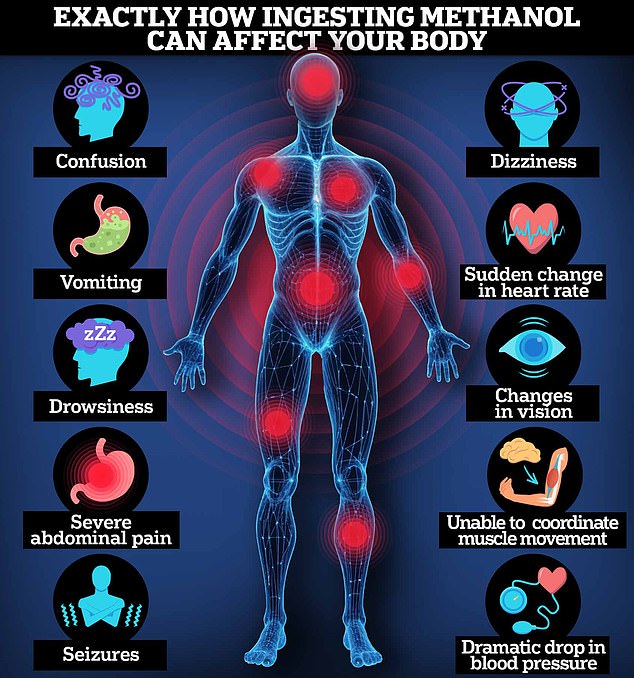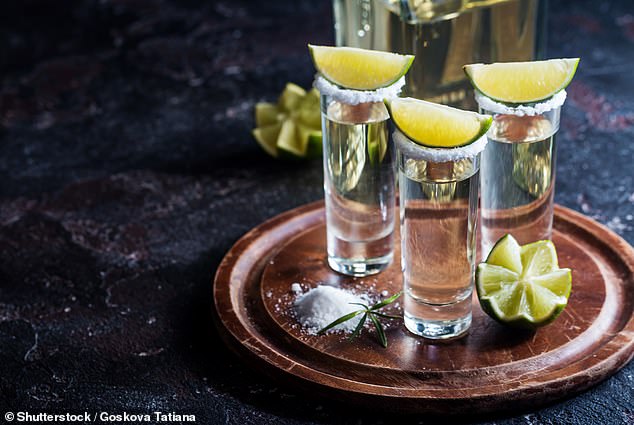Experts have revealed a surprising cure for methanol poisoning after alcohol contaminated with the substance killed six people in Laos and hospitalized a dozen more.
Methanol, a powerful chemical found in paint thinner, is often mixed with counterfeit alcohol to boost profits in some parts of the world because it is cheap to produce.
Just one bite can be enough to kill and two teaspoons can blind you.
But a surprising cure for methanol poisoning is the very chemical it is designed to imitate; alcohol.
Administered intravenously or simply by drinking in a clinical setting, alcohol can slow the breakdown of methanol, which is responsible for its toxic effects.
This gives doctors additional time to save the life of a potential victim.
However, patients may need to be kept drunk for up to a week (and under close medical supervision) to ensure the correct dosage and remove the methanol from their system.
It comes after a Laotian doctor who treated one of the victims said he originally treated her with fluids and vitamins, suspecting she had consumed too much cannabis.
A surprising cure for methanol poisoning is the very chemical it is designed to imitate: alcohol. stock image
The patient, Holly Bowles, 19, later died in hospital.
Alcohol is considered one of the first-line treatments for suspected methanol poisoning in many parts of the world.
It works thanks to an interaction between methanol, the liver and alcohol.
Methanol, by itself, is not toxic to the body. Only when the liver breaks them down do their chemical components begin to wreak havoc.
These components cause the blood to become acidic, damaging cells and organs.
If left untreated, this can lead to permanent damage or death.
Professor Alastair Hay, an expert in environmental toxicology at the University of Leeds, explained that alcohol, known chemically as ethanol, prevents the liver from processing methanol.
‘The principle behind ethanol administration is quite simple; slows methanol metabolism,” he said.
He explained that both substances are broken down by the organ in the same way, but since alcohol does it more efficiently, it is prioritized by the body.
Professor Hay said this preference for alcohol gives the body time to get rid of methanol in other ways that do not result in organ damage, such as through urine and sweat.

British lawyer Simone White, 28, from Orpington, Kent (pictured), died after drinking free drinks allegedly laced with deadly methanol.


Melbourne teenagers Holly Bowles (left) and Bianca Jones (right), both aged 19, died this month after a night out in the party town of Vang Viang after drinking contaminated alcohol.

In milder cases, and if given quickly enough, alcohol may be the only treatment a patient needs to recover.
“If the poisoning is not too severe and only blood tests can determine this, ethanol alone may be sufficient,” Professor Hay said.
In more severe or delayed cases, keeping a patient “slightly drunk” can give time for other treatments such as dialysis to cleanse the blood of methanol toxins to work, he said.
Doctors Without Borders (MSF), also known as Doctors Without Borders, recommends alcohol as a possible treatment for methanol poisoning.
MSF’s Dr Knut Erik Hovda described it as the “most important antidote” in comments to the bbc.
However, a medication called fomepizole, which works on the same chemical principle as alcohol, is preferred in all circumstances, if available.
Doctors consider it more effective because it is easier to control the dose to counteract the methanol. It also has fewer side effects than alcohol for patients, including sedation or behavioral changes.
However, it is expensive – costing almost £4,000 a dose in some parts of the world – meaning alcohol is generally more available.

Here, we reveal how the substance can wreak havoc on the body within hours of taking it, leaving drinkers paralyzed, unable to breathe and at risk of losing their sight.
It comes as Dr Yaher, who treated one of the Australian Laos poisoning victims, Holly Bowles, 19, told the Times that when he first examined the young woman she was “confused” and “drowsy” .
“We asked him what he had eaten or drank, but he didn’t know what had happened,” he said.
He said doctors initially suspected Bowles had consumed too many cannabis edibles that were popular with tourists.
‘We treat it symptomatically. We started him on an IV drip and gave him vitamins. But after 30 minutes he had a seizure and fell into a coma.
She became the sixth victim, and her death followed that of her friend Bianca Jones, also 19, as well as British lawyer Simone White, 28, from Orpington, Kent.
Three other deaths, two Danes and one American, have also been recorded in connection with drinks served in the Laotian town of Vang Vieng, popular with backpackers.
Doctors and experts are keen to highlight that the time needed to seek medical help is by far the most critical factor for the outcomes of methanol poisoning and urge travelers to be alert for possible signs.
Symptoms of methanol poisoning usually develop between 12 and 24 hours after drinking, differentiating it from alcohol poisoning, which usually occurs sooner.
However, symptoms may appear even after 24 hours if enough alcohol has been consumed to delay the initial breakdown of methanol, similar to how it is used as a treatment.
Signs of methanol poisoning include confusion, dizziness, drowsiness, vomiting, vision changes, and abdominal and muscle pain.
Patients often complain of a severe or unusual “hangover” in the initial stages, followed by breathing problems, vomiting and abdominal pain, as well as vision problems.
If a patient is not treated, they can fall into a coma as their body begins to shut down.

